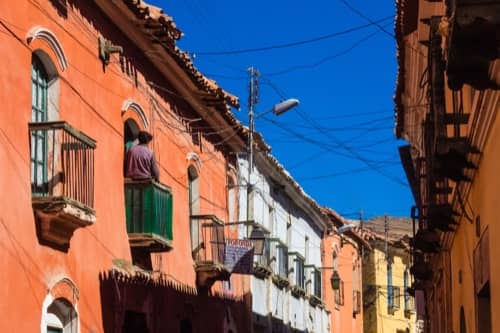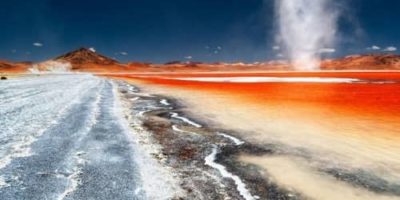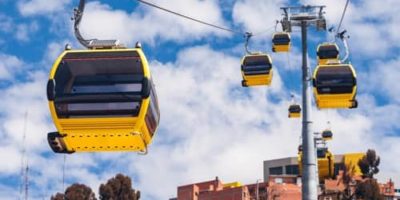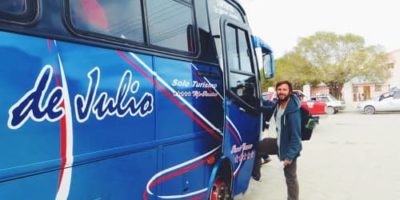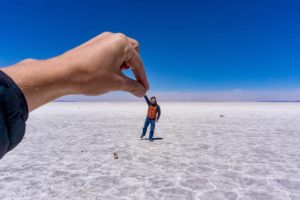The city of Potosi, which at one time was the closest thing to the capital of the world, still thrives in the shadow of Cerro Rico. Potosi is a beautiful city whose colonial architecture speaks of how it became one of the greatest centers of power in the world.
If you’re short on time, the best things to see in Potosi are:
- Cerro Rico
- Laguna Colarada
- Torotoro National Park
- Casa Nacional de la Moneda
- Santa Teresa Convent Museum
However, I recommend that you spend a few more days exploring this region of Bolivia since there are several other interesting things to see. Let’s explore the best things to do in Potosi.
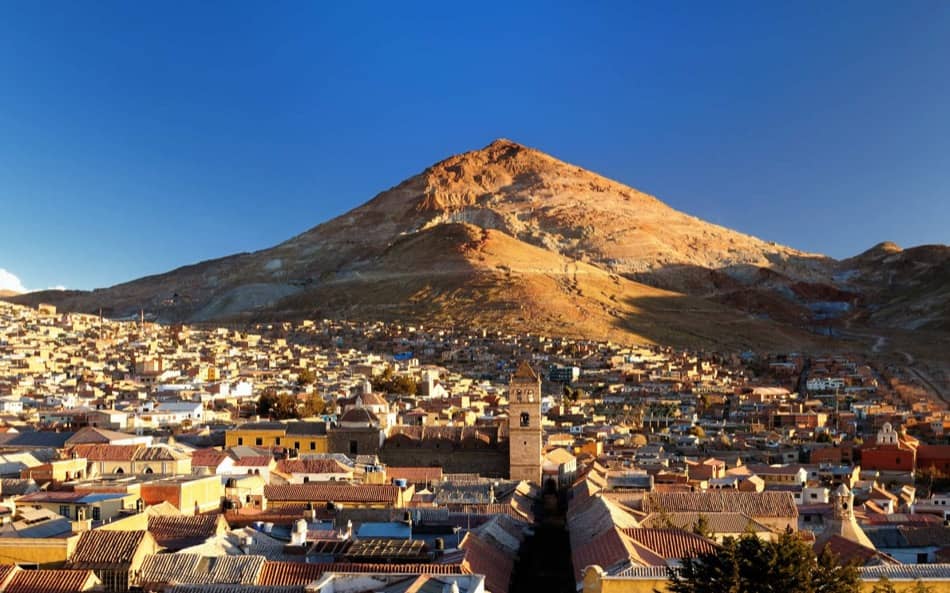
If you haven’t decided how you’re you’re going to travel to Potosi, here’s my post about how to get to Potosi from different cities in Bolivia.
Here's a list of the best hotels in Potosi.
Contents
Cerro Rico
You can’t really understand the history of Potosi until you understand the history of Cerro Rico.
The treasure hidden in Cerro Rico was found by chance, almost 500 years ago, when a llama herder went in search of one of his lost animals. As it became dark, he lit a fire to warm himself and spent the night. The next morning, under the fire and as a result of the intense heat, silver threads appeared. Soon the Spanish conquerers found out and took possession Cerro Rico and all its riches in the name of the Spanish crown.
In 1547, they began to mine in the Cerro Rico which was the biggest reserve of silver in the world at that time. Today, and almost 500 years later, Cerro Rico continues to be an active mine although the amount of silver is scarce now mainly contains zinc.
To learn more about the history of Cerro Rico and explore the mines, I suggest taking a tour. Here are some things you should consider before booking a tour:
- The tour is NOT suitable for everyone. You have to climb stairs, go through holes, go crouching for a long time and even crawl at times
- Everything is dark and very dusty.
- You will need to buy a mask to enter the mines. Sometimes there’s so much dust that it’s hard to breathe.
- If you are claustrophobic, I recommend avoiding the tour. The mine corridors are very narrow and dark.
- If you have a professional or expensive camera, I suggest leaving it at the hotel. There is a lot of dust in the mine and you can easily damage your camera by dropping it or hitting it against the mine walls. A smartphone camera is good enough for the pictures you’ll take.
A typical tour lasts for three hours or so and includes transportation from the city, equipment (helmet, jacket, pants, boots, flashlight), an old miner who acts as a guide, and access to one of the mine entrances. The departures are daily in the morning at 9AM and in the afternoon at 2PM. It costs approximately 100 BOB per person.
The first stop on the tour is the market where the miners go to buy the material they need to work in the mine, such as: explosive material, dynamite, ammonium nitrate, detonator, fuse, bleach, mining cigarettes, coca leaves, alcohol, etc.
Next, you get to enter the mines. You’ll have to descend amongst narrow galleries, dark passages and rocky paths while breathing in dust and silica. Here you get to meet the miners and see how they work. After this visit, you get a chance to stop for a few minutes in the Plaza el Minero, where there is a sculpture that pays homage to all the miners of Potosi.
Remember! This tour is not appropriate for people who suffer from claustrophobia, reduced mobility, respiratory problems or are feeling the effects of altitude sickness, etc.
Laguna Colorada
The Laguna Colorada is probably my favorite place in Bolivia. When I first went there, I couldn’t believe something like this existed. It is a 60km2 lagoon and it owes its intense red color and white brushstrokes to the minerals that rest in it along with the pigment of the algae that make it up. Many flamingos live in the red lagoon and it is possible to see three types of them: the Chilean, the Andean and the James.
You can also see many llamas and alpacas eating algae at the edge of the lagoon. Overall, you get to see a whole palette of colors in this exceptional landscape. It is truly a wonder of nature. Check out this post if you’re wondering whether you can swim in Laguna Colorada.
Getting there from Potosi is not easy and it’s generally a part of the Salar de Uyuni tour where you arrive here at the end of the second day. That said, it’s totally worth making the trip. Really the Laguna Colorada is an overwhelming place. At 4275 meters above sea level, this lagoon, with its red waters and full of flamingos, represents one of the greatest visual and scenic spectacles that can be appreciated in the highlands (if not on the whole planet).
To walk among the flight of hundreds of flamingos, in absolute solitude, with the red mirror that the lagoon represents with the mountains, is an experience that will remain with you forever.
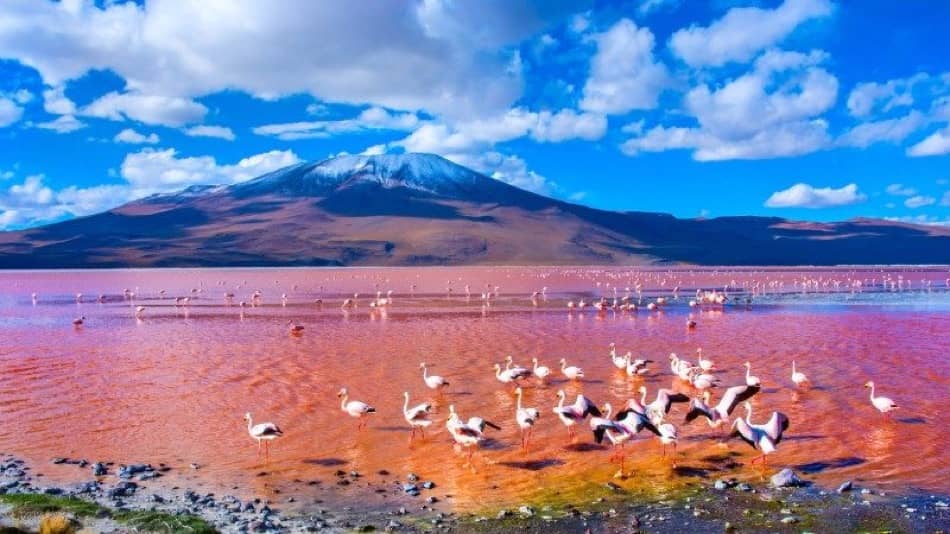
Torotoro National Park
Millenary caves, deep canyons, waterfalls and dinosaur footprints. The Torotoro National Park is a geological marvel without equal. With every step you take there is the possibility that you will stumble upon fossils and even bones of our most ancient ancestors, Dinosaurs. Torotoro National Park is a true paradise in Bolivia for those interested in paleontology, archeology and culture in general.
ToroToro National Park is the fourth most visited place in Bolivia and a place full of attractions that you can spend 4 to 5 days to discover. Here are the main attractions:
Dinosaur Tracks
ToroToro is the region with the greatest paleontological representation in Bolivia and one of the most important in Latin America. Here you will be able to see different dinosaur footprints from the Upper Cretaceous period. In total, 3500 footprints have been found in Toro Toro National Park, of which you can see about 1500.
Tortugas De Molle Cancha Cemetery
In an area of approximately 7 hectares, the Tortugas De Molle Cancha Cemetery hasfragmented fossils of Chelonians. You will see a lot of evidence that ToroToro was once a sea bed.
Umajalanta Cave
The Umajalanta Cave is one of the main attractions of the ToroToro National Park, and is the deepest cave in Bolivia and a site of high scientific and speleological interest. The cavern has not been fully explored yet and is full of interesting things like stalactites and stalagmites.
From the entrance you can see enormous stones and a river. Inside, there are impressive galleries and formations of leaves, columns, stalactites and stalagmites. It is remarkable to appreciate the mineral formations that hang from the ceiling of the limestone caves in their various phases considering that they grow 1 cm every 20 years.
El Vergel and Torotoro Canyon
The Torotoro Canyon is located 4 kilometers from Torotoro. In the tour through this canyon you can see dinosaur footprints and geological formations. Going down to Vergel you can take a bath in the river of crystalline waters and observe the subtropical vegetation of the area. It is very common to see endemic birds such as the red-faced parabas or condors.
Chiflon Qaqa Cave
The Chiflon Qaqa Cave has stalactites and stalagmites, which are very well preserved.
Chaqui Flame
Chaqui Flame is an archaeological site Located 19 Kilometers from the center of town and settled on the slope of Wayllas Hill. Llama Chaqui, which means Llama foot, is a site that is considered to have been an Inca settlement. You will be able to see terraces and retaining walls.
Cave Paintings
These cave paintings are also one of the most important attractions of ToroToro.
They are located to the northwest of the town in the middle of rocky farallones; a series of pictorial representations is perceived, whose symbols of geometric forms have not been deciphered yet. Some of them can also be seen in Ciudad de Itas.
Ciudad de Itas
Ciudad de Itas are unique rock formations in Bolivia, product of water erosion (200 million years ago, the place was pure sea) and wind, which resulted in large cavities that resemble a city of stone. In the area, 400 years B.C. lived the Itatas community, from which the name of the place comes from. As a result of the presence of this community, today cave paintings can be seen inside the caves, illuminated by the sun that enters through the cavities in the roofs.
Casa Nacional de la Moneda
Considered one of the most important museums in Bolivia, visiting the Casa Nacional de la Moneda is a jump into the past.
The architecture of the mint is incredible, it has been very well preserved over the years. You will experience the very history of Potosi, the work of silver and minting of coins at the cost of slave lives. And as if that were not enough, you can take a souvenir of your own coin that you minted yourself.
I recommend taking a tour to understand the beginnings of the mint and the evolution of Potosi. You’ll experience a mix of sensations about human ambition, slavery and eventual economic progress. It was by far, one of the best tours I have taken in the museums of Bolivia.
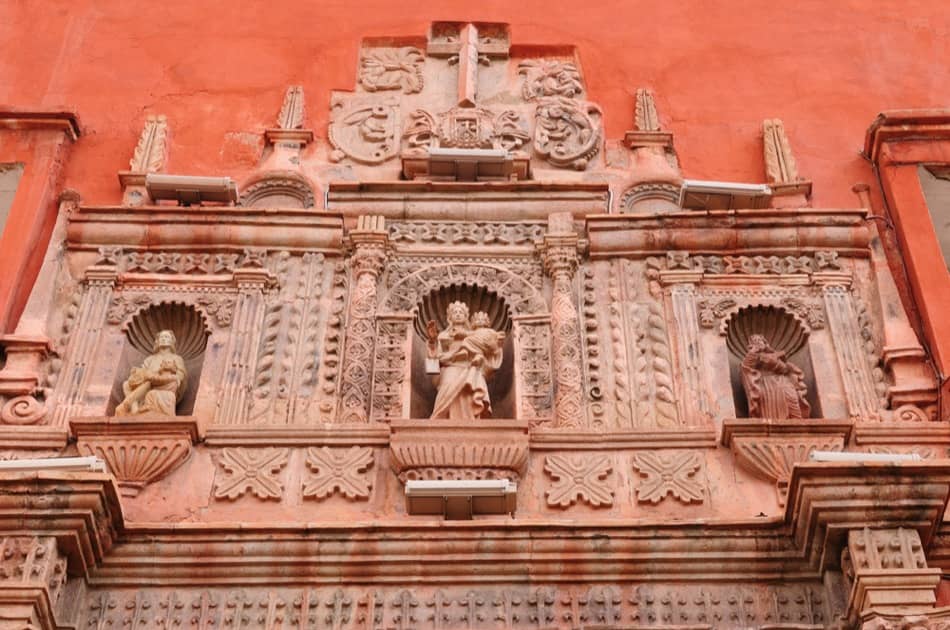
Santa Teresa Convent Museum
Visiting the Santa Teresa Convent Museum is a must when you’re in Potosi. You get a great insight into the life that the nuns led, art, painting, daily life, unique objects that they used daily.
I recommend taking a tour which lasts 2 hours and costs 30 BOB. One strange requirement in the convent is that you need to pay extra if you want to take pictures. Although it seems silly, it’s worth paying the extra fees to take some pictures. The museum is very nice, and the tour is well guided. You can interact with the guide or walk around on your own. At the end of the tour, you have the option of buying products that are actually made by the cloistered nuns.
San Francisco of Potosi Convent and Temple
Embedded on one side of a narrow street, the San Francisco convent has rested there since 1547 and is considered the oldest monastery in Bolivia. Inside, a religious museum and extraordinary views await you.
Legend has it that the Christ of the True Cross, which is venerated inside, appeared in a box outside the church. And his hair and beard grow. Every September 14th they make a ceremony and cut it. The price to enter is 15 BOB which includes access to the roofs of the church from where you can see the marvel of colonial construction and a 360 degree view of the city and Cerro Rico.
San Lorenzo Church
The front of the Church of San Lorenzo, built in the 18th century, is one of the most beautiful representations of Mestizo or Andean Baroque architecture. The stone entrance, shows Solomonic columns and an abundant decoration with bunches of fruits and tropical vegetation. In addition, two feminine figures that have been called “indiátides” are used as supports.
San Lorenzo was the old main church of Potosi, and San Bernardo the Republican Cemetery. Viceroy Toledo commissioned the rectangular layout and opening of checkerboard streets only in 1570, when the town was already quite populated. O
n the southern side, 22,000 people died from an epidemic (of the 60,000 inhabitants), and thousands more shortly after that, from the bursting of the San Ildefonso lagoon. The remains you see in the center are colonial remains that survived the explosion. 58 blocks of the south side were razed to the ground, and today they are still underground.
Potosi City Cathedral
The Cathedral of Potosi is a true tourist icon both inside and outside. The interior shows an architecture that blends with the paintings and relics on display, while the exterior harmonizes with the surroundings, which are tinged by the imposing Cerro Rico, the Casa de la Moneda, the tower of the Compania de Jesus, San Francisco, the church of La Merced and other colonial monuments that represent part of the tourist and historical wealth of the city of Potosi.
I recommend taking the guided tour of the church to learn more about its history and all the spaces that make it up, from the crypt to the bell towers. It costs 20 bolivianos per person and consists of a 30 minute guided tour passing through the different parts of the cathedral arriving at the bell tower. It is worth climbing the 95 steps of its bell tower to have one of the best views of the city of Potosi.
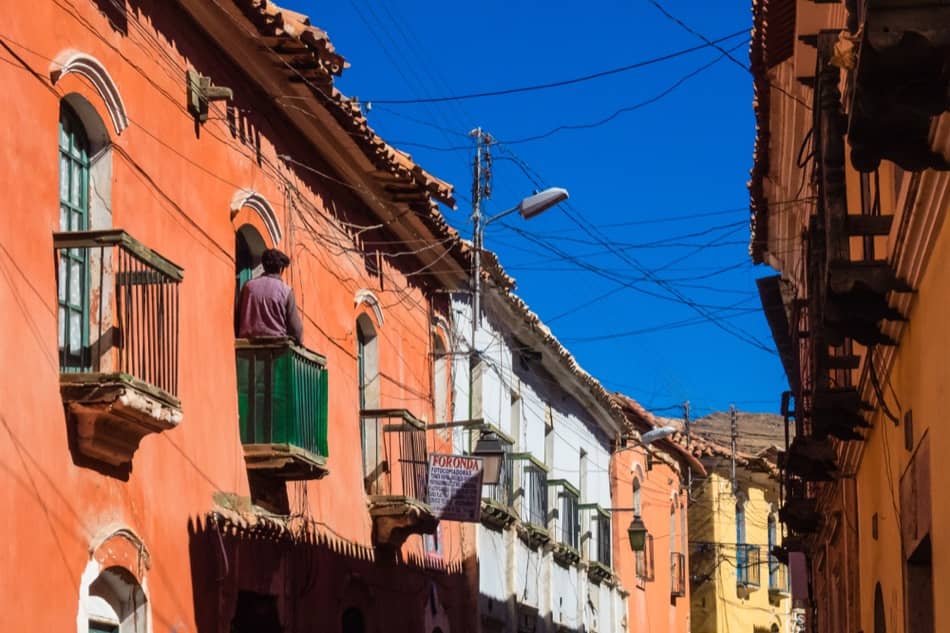
Plaza 10 de Noviembre
The Plaza 10 de Noviembre is the square where the cathedral, the town hall and the Mint are located, so you will surely pass by there. It’s a very lively place at any time of day, where you can see indigenous women in their typical costumes.
In the morning many merchants gather in the square. It’s a great time to recharge your batteries and try some street juices or some delicious salteñas. Personally, I find it much more picturesque at night than during the day. The lighting at night, along with the illumination of the surrounding buildings, makes it magical and unique.
Despite the fact that Potosi is a world heritage site and there are plenty of tourists, the square retains a provincial style and is a meeting place for the people of Potosi themselves. This is a place where the local people go to chat, eat ice cream or go on a date. That’s why I like to sit in this square and watch the people as well as the beautiful buildings that surround it.
Ojo del Inca
The “Ojo del Inca” is one of many lakes that you can find a few kilometers from Potosi. A lagoon of volcanic origin, its waters are warm and pleasant. With a circumference of about one hundred meters, they form an almost perfect circle, which gives it an incredible appearance.
It is said that Tupac Amaru and other Incas used to bathe in its waters, which is why the place earned the name “Inca Baths”. There’s not much else to see in the area thought it is a beautiful place to visit and take pictures.
You should know that there are no toilets in the area.
Laguna Negra
Also known as Laguna Misteriosa and Laguna Turquiri, Laguna Negra is a dark-colored lagoon that is hidden among rocks and surrounded by fields full of llamas. The Laguna Negra is hidden in an extraordinary landscape that merges the typical plains of the highlands with canyons of strange rock formations. Its dark color is mainly due to the type of algae found at its bottom.
Another place that’s generally visited during a trip to Salar de Uyuni, to reach it by 4×4, you have to leave the main track and take a small path of rock and sand that ends at the edge of a small valley. Once there you have to abandon the rattle of the all-terrain vehicle and walk about 15-20 minutes through the lower part of the valley.
Laguna Hedionda
Very close to the Chilean border (most of the tours to the Salar de Uyuni start in San Pedro de Atacama), we find Laguna Hedionda. Laguna Hedionda (Hedionda stands for “Stinking” in Spanish) is one of the lagoons visited with the 3 day excursion to the Salar de Uyuni. Like the Colorada and the Verde, it is worth it.
Due to the composition (sulphur) and the a lack of drainage and flow, it has an intense smell. That is more than made up for by the fact that you can see Andean flamingos in their habitat, as well as vicuñas, llamas, viscachas and other birds that live together in an impressive natural environment.
Pueblo Pulacayo
Pulacayo is a canton located in the municipality of Uyuni in the province of Antonio Quijarro, in the department of Potosi. It can be reached in three hours from Potosi through a paved road in very good condition.
Many people left and Pulacayo was practically a ghost town. Currently, it has about 400 inhabitants and people are beginning to return. After being a “ghost town” for several years, Pulacayo has been reborn. This has been possible thanks to the implementation of the Huanchaca-Pulacayo Mining Museum.
In 2017, the work began in the Pulacayo mining center, where the Huanchaca mine (which in Quechua means “Bridge of Sorrows”) is located. The history of this mine began at the end of the Colonial era, passed through the Republic, and went through the entire contemporary modern process. So as you can imagine, there’s a lot of history here and it’s definitely worth a visit.
Tarapaya
The main highlight in the town of Tarapaya is a warm water lagoon in an always cold/cool place. Diving in this lagoon is a moment of pleasure and delicious relaxation. The entrance is cheap and it is possible to arrive by local bus from the center of Potosí.
The village is very small and the market is absolutely great. Go into the small alleys and enjoy the market. At the main square, you will find the indescribably beautiful (and expensive) woven handicrafts. The simple ones are woven by women and the colorful and elaborate ones by men.
Overall, Tarapaya is great getaway from all the dust of Potosi.
Museo Diego Huallpa
In the Museo Diego Huallpa museum, you can learn about the living history of mining, from centuries ago to the present. Forms of extraction, tools used, dangers and diseases faced by miners, their great sacrifice and their short life expectancy.
The museum is located on level 0 in the Cerro Rico and you walk about 15 minutes with protective clothing, helmet, lamp and rubber boots into the mountain and get a great impression and a lot of information about the life threatening mining work.
To make sure that you can visit the museum, you should go by the office of “South America” in the morning. The office is directly opposite the entrance of Casa de la Moneda. This is the office that runs the museum and where you will find the guide who will take you to the mine.
Arco de Cobija
The interesting thing about Arco de Cobija is its history. It is also a great spot to take pictures of the beautiful view of Cerro Rico and its picturesque surroundings. I recommend visiting the Arco de Cobija with a tour guide so you can learn about it’s history so it makes more sense.
Going to the arch around sunset allows you to enjoy a landscape full of colors, with Cerro Rico in the background highlighting its reddish tones. Just around the corner is the beautiful Church of San Benito, a temple built so that the indigenous could go to mass without mixing with the Spanish.
Iglesia San Bernardo
The Iglesia San Bernardo is closed to the public but you can take pictures from the outside. Located in San Bernardo Square, it has a beautiful facade and is surrounded by trees.
